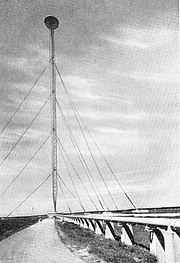Germany transmitter III
|
Germany transmitter III
|
||
|---|---|---|
| Basic data | ||
| Place: | Herzberg (Elster) | |
| Country: | Brandenburg | |
| Country: | Germany | |
| Altitude : | 80 m above sea level NHN | |
| Coordinates: 51 ° 42 ′ 59.5 " N , 13 ° 15 ′ 51.5" E | ||
| Use: | Broadcasting station | |
| Demolition : | 1947 | |
| Mast data | ||
| Construction time : | 1939 | |
| Building material : | steel | |
| Operating time: | 1939-1945 | |
| Total height : | 337 m | |
| Operation room: | 333 m | |
| Total mass : | 600 t | |
| Data on the transmission system | ||
| Waveband : | LW transmitter | |
| Radio : | LW broadcast | |
| Shutdown : | April 21, 1945 | |
| Position map | ||
|
|
||

The Deutschlandsender III was a long-wave radio transmitter put into operation in Herzberg (Elster) in 1939 , which broadcasted the German broadcaster's program on the frequency of 191 kHz .
At the time, it was one of the most powerful radio transmitters in the world with a transmission power of 500 kilowatts, but - contrary to Nazi propaganda - there were comparable systems abroad. Without - as antenna support a served top capacity - 325 meters high, insulated against the earth guyed mast radiator , carrying on its top a lenticular top capacity of 25 meters in diameter and four meters high, the inside was passable. Since this mast also stood on an eight-meter-high voting house , the entire structure was 337 meters high and was at that time the tallest structure in Europe and the second-tallest structure in the world after the Empire State Building . Only 600 tons of steel were used to build the tower, which was made possible by the special construction. A ladder with 1,600 rungs led up through the lattice structure. It was also noteworthy that this mast had no flight safety lights. Instead, its top was illuminated with the help of three rotating flak spotlights mounted on small masts during the night.
It was planned to expand the system to a circular group radiator . For this purpose, ten transmission masts, each 275 meters high, were to be erected around the central mast on a circle with a 1425 meter diameter. At the planned location of mast 9, the construction of a reserve antenna in the form of a triangular surface antenna began in 1944 , consisting of three 150 meter high masts that formed a triangle with 210 meters. Because of the rapidly worsening war situation, this work could not be completed.
The transmitter unit was badly damaged in a bombing raid on April 21, 1945 and thus unusable, although the mast remained undamaged. It was later dismantled by the Soviet occupation forces with all the technical equipment . The dismantling of the transmitter mast began in July 1946 and was completed on December 23, 1947. In 1959, a waterworks was built on the site of the former transmitter building. Remains of the facility - in particular the blasted foundation of the transmitter mast and the former housing estate of the employees on the street "Am Sender" - have been preserved. It is not known whether and where the mast was rebuilt.
literature
- Helmut Knuppe: a giant among giants. The rise and fall of the German broadcaster III in Herzberg (Elster). A home book. 2nd edition, Leipziger Verlagsgesellschaft-Verlag for cultural history and art, Leipzig 2004, ISBN 3-910143-85-7 .
- Gerd Klawitter: 100 years of radio technology in Germany. Volume 1 ( The radio stations around Berlin. ) 3rd edition, Funkverlag Bernhard Hein eK, Dessau-Roßlau 2004, ISBN 978-3-936124-65-1 .
- Bernd-Andreas Möller: Manual of the radio transmitting and receiving stations of the German Reichspost. Series of publications on radio history - Volume 15, Verlag Dr. Rüdiger Walz, Idstein 2005, ISBN 3-936012-05-9 .



